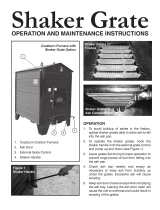
7
TECHNISCHE DATEN
This is a Design 1 fire and has a connection for
fitting to a chimney that is equipped for other fires
and boilers for solid and liquid fuels, insofar as the
chimney dimensions are in accordance with DIN
4705, Part 3.
TECHNICAL DATA
Dimensions (mm) and weights (kg)
Height:
1263
Width:
516
Depth of the corpus
441
Weight without casing:
132
Weight with ceramic casing:
150
Flue pipe outlet diameter:
130
Rated heating capacity as per EN13240
6 kW
lowest thermal output
3 kW
Room-heating capacity depending on
house insulation
70-160 m
3
Fuel flow
1,7 kg/h
Efficiency
82,3 %
CO
2
content
9 %
CO emission rel. 13% O
838 mg/Nm
3
Dust emissions
20 mg/Nm
3
Exhaust values for multiple use of the chimney ac-
cording to DIN 4705 or to dimension the chimney
according to DIN 4705.
Exhaust mass flow
6,3 g/s
Exhaust temperature
201,7 °C
Minimum feed pressure at rated useful heat
12 Pa
The owner of small firing systems or the person
authorised for the small firing system is to keep the
technical documentation and is to submit it to the
authorities or the chimney sweep on request.
PACKAGING
Your first impression is important to us!
The packaging of your new stove provides excellent pro-
tection against damage. However damage to the stove and
accessories may still occur during transport.
Therefore please check your stove on receipt for dam-
age and completeness! Report any deficiencies to
your dealer immediately! Pay particular attention dur-
ing unpacking that the stone and ceramic panels re-
main intact. Scratches to the material can easily occur.
Natural stone and ceramic panels are excluded from
the warranty.
The packaging of your new stove is environmentally neu-
tral to a great extent.
The wood used in the packaging has not been surface
treated and may therefore be burnt in your stove. The
cardboard and film (PE) can be disposed of via the
municipal waste collection for recycling.
PARTS - OVERVIEW
(fig. Page 3 - 5)
Description
1 Furnace door black B15287
1 Furnace door metallic B15288
2 Fire door handle B14561
3 Hexagon socket screw 104622
4 Culimeta 103693
5 Combustion chamber door glass Z32439
6 Toroidal sealing ring 100485
7 Glass holder L00475
8 Top fire strip Z30550
9 Hexagon bolt 107488
10 Tightening stud Z15746
11 Spacer Z10042
12 Bottom fire strip B15868
20 Baking compartment door black B15476
20 Baking compartment door metallic B15510
21 Baking compartment door handle Z32813
22 Culimeta 103693
23 Baking compartment door glass Z32774
24 Glass holder L00475
25 Hexagon socket screw 108830
30 Insulation plate Z33492
31 Flue plate Z32807
32 Insulation plate Z33493
33 Secondary air regulator black Z32786
33 Secondary air regulator metallic Z32844
34 Baking compartment frame black B15475
34 Baking compartment frame metallic B15508
35 Baking compartment B15473
36 Cleaning shaft Z32815
37 Cleaning slide L00706
38 Double ball snap assembly 110461
39 Closing plate B12322
40 Primary air valve black Z32451
40 Primary air valve metallic Z32452
41 Shaker grate handle black Z32454
41 Shaker grate handle metallic Z32455
42 Shaker grate Z25946
43 Ash pan - tray L00617
44 Shaker plate Z25948
45 Hexagon socket screw 100061
46 Ash drawer L00618
47 Wood catcher black Z32791
47 Wood catcher metallic Z32843
50 Side cladding ceramic
51 Aluminium profile Z32754
52 Lid black B15474
52 Lid metallic B15509
53 Flue gas connection Z10020
54 Rear wall black Z32810
54 Rear wall metallic Z32876





















